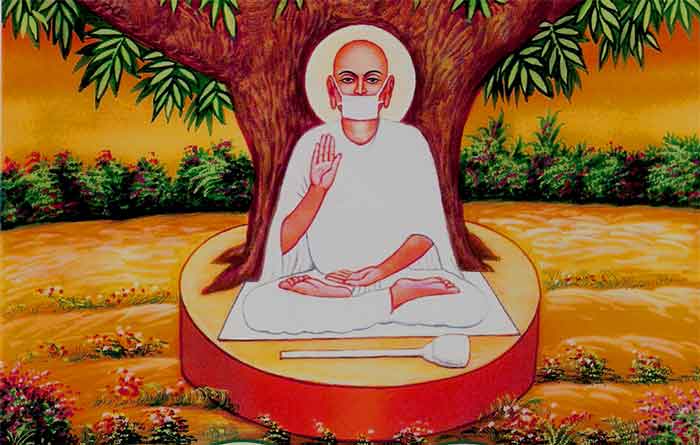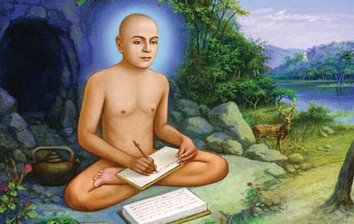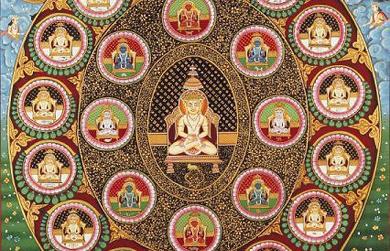Important Facts about Jainism

Other important facts-
- Name of eleven ganadhara of Jainism
- What is jain philosophy
- 24 of tirthankaras Jainism
- Five types of knowledge in Jainism
- Jainism Triratna
- Jainism according to world six substance
- Two communities of Jainism: Digambar and Shwetambar
- Jainism: Who was Parshvanath, 23rd Tirthankar
Jainism is the oldest religion in India. Jainism is the meaning – the religion by jin. Those who are followers of Jain are called Jains. The word “jin” means that who won his mind, speech, and his work, and acquired absolute knowledge by acquiring specific knowledge, he is called Jainswar or jin is called.
The basic principle of Jainism is non-violence. According to Jainism, there is no Creator of this creation or any organism. All the creatures enjoy the fruits of their actions. In Jainism, God was not considered a creator. The source that mentions the very ancientity of Jainism is Vedic literature.
Features of Jainism-
- According to the Jain tradition, there were 24 Tirthankaras in this religion. These are the first Rishabhdev. The 23rd Tirthankar is Pashwarnath. Mahavir Swami was the 24th Tirthankar.
- But the information about the history of the earlier pilgrims excepting the 23rd Tirthankar is half-complete.
- Paswanath ka kal Mahavir Swami 250 BC is believed. Their followers are called Nirgrnth. According to Jain recollections, Parshwanath had attained Nirvana on the Sammed mountain at the age of 100 years.
There are four Mahavratas, preserved by Pashwannath.
- truth
- Nonviolence
- Renunciation
- Astyay
- Mahavira was born on 540 B.C. to Siddhartha, the head of the Kundagrama near Vaishali and the head of Vajji Sangha. His mother was Trishala (princess of the( Lichchavi Republic), who was the sister of Chetk. And his wife was Yashoda.
- The daughter of Mahavira, born from Yashoda, was Priyadarshana who was married to a Kshatriya named Jamali, who was Mahavira’s first disciple.
- At the age of 30 Mahavira gave up home.
- After 12 years of rigorous penance and sadhana, at the age of 42, Mahavira got Kaivalya (supreme knowledge) under the sal of tree of the river on the banks of river Rijupaliika near Jambhiigram.
- After the Kaivalya was received, Mahavir Swamy was called Kaolin, gin (conqueror), arh (deserving) and nirgrantha (bandhan Rahit).
- Mahavira Swami died in Pava at the age of 72 in 468 BC.
- In Buddhist literature, Mahavira has been called Niganti-Nathpunt.
- In the Jain book, Acharang Sutta, detailed description of Mahavira’s description and work.
- In the four Mahavrutas presented by Pashwannath, Mahavir gave 5th Mahavrat (Brahmacharya) Jora.
- The ultimate goal of Nirvana jivas in Jainism is to destroy, destroy the karmic fruit and remove material elements from the soul, Nirvana is possible.
Jain is related to religion-
(i)Asrava- The flow of karma towards life.
(ii)Saavar: When the flow of action stops towards the creature.
(iii) Nirjara: Water burning of residual work means the depletion of already existing works.
(iv)Bandhan– Combining karma with the organism.
According to Jain philosophy, this world is made up of 6 substances-
creatures
- Pudgal (physical element)
- religion
- Unrighteousness
- Sky
- period
- creatures
Five types of knowledge have been defined in Jainism-
- Mati: sensory born knowledge
- Shruti: Hearing Knowledge
- Duration: Divine Knowledge
- manahparyaya: Knowledge of the mind of other people
- Kaivalya: Full Knowledge (Knowledge of the Secrets and Jigandris)
For the monks, the order of FiveMahavrat is stated in Jainism-
- Ahinsa Mahavrat
- Satya Mahavrat
- Ashay Mahavrata (not stealing)
- Apirigrah Mahavrat
- Brahmacharya mahavrat
Arrangements for Five Anuwrton for Households-
- Nonviolence Anuwrton
- True Anuwrton
- Asteya
- Renunciation
- Brahmacharya
According to Jainism, there are three sources of knowledge-
- pratyaksh gyaan
- make a guess
- Tithankaron’s words
Jain is the Trirat of religion
- samyak shraddha
- samyak gyaan
- samyak aacharan
- After liberation can be rid of the cycle of life and travel. Such a person achieves eternal philosophy, eternal semen, eternal happiness, these are called anant chatushtay.in Jain races.
- syadavada(anekantavada) or Saptbhangayya is called the theory of relativity of knowledge.
- Mahavir established a union in his life time, which included 11 followers, who were called the Gandhar.
- In the life sangh of Mahavira, only 10 Ganeshaas died, after Mahavira only Sudharman was alive.
- In Jainism, the existence of the deities has been accepted, but the place where the place is below.
- Jainism accepts the reality of the world but does not accept God as the creator.
- There is special emphasis on non-violence in Jainism. It has been banned from participating in agriculture and war.
- Jainism believes in rebirth and activism, according to him, karmalha is the cause of birth and death.
- Jainism accepts the reality of the world but does not accept God as the creator.
- There is special emphasis on non-violence in Jainism.
- It has been banned from participating in agriculture and war.
- Jainism believes in rebirth and activism, according to him, karmalha is the cause of birth and death.
- Writing in Jainism means the sacrifice of the body by fasting. Being well-rendered is the only mention of death. Third Shadow Emperor Chandragupta Maurya had sacrificed his body only by writing method in Shravanabelagola (Karnataka). In the Ashok pillar articles, the process of adopting this process was also administered by the felonious criminals.
- In modern times, the writings received widespread support from great men like Mahatma Gandhi and Vinoba Bhave, Father of the Nation.
In time, Jainism split into two communities-
- Terapnthi(Shwetambar)
- Samayya (Digambar)
- Bhadrabhu and his followers were called Digambar, they were called Southern Jain.
- Sathasbahu and his followers were called Shvetambara.
- The people of Shwetambar sect first started worshiping Mahavir and other pilgrims, they used to wear white robes.
- In the time of Rashtrakut rulers, there was a special publicity of Jainism in Southern India.
- Jainism 11th and 12th century in Gujarat and Rajasthan in More popular .
- There were two main centers Ujjain and Mathura in the north of the Jains in India.
- In Jain temples of Dilwanga, Jain Tirthankar Adinath, Neminath is famous.
- Khajuraho has the temples of Pashwannath, Adinath.
- According to the Jain tradition, Aristnemi was contemporary of Bhagwat Dharma of Vasudev Krishna.
- In the Jain religion, its founder and jitendrai and the eminent sages of knowledge are the tirthankar, till now there are 24 Tirthankaras, the last pilgrimage was Mahavir Swami,
The symbols of Jain Tirthankar are as follows:
- Rishabhdev (Adinath): vrshabh
- Shantinath :Deer
- Pashwarnath: Sharpfun
- Mahaveer: lion
In Vedic Mantras (Rig Veda) only two Tirthankaras get mention of Rishabhdev and Arrastnemi.
Members of the Jain Union were divided into four classes-
- Monk
- Randy
- Shravak
- Shravika
The fundamental Principles given by Mahavira are compiled in 14 ancient texts, which are called earlier.
- Jain monasteries are called Basadi (Bassadis).
- The 11 major disciples of Mahavira are called Gandharva, Gandharva has a literal meaning – Principal of schools.
- Jain scriptures have been written in the Ardh magadhi language.
- Jainism has given special emphasis on tenacity and non-violence.
- The important treatise of Jainism is written in Kalpasutra Sanskrit.
- Jainism did not recognize the authenticity of the Vedas and opposed Vedas.
- Jain Darshan resembles Sankhya Darshan.
- After Mahavira’s death, Jain Sangh’s first president was Sudharman.
In South India there were states to protect Jainism –
- Gang
- Kadamb
- Chalukyas
- Rashtrakut
- Kharavel’s Hathigunfah Anchart, Khandakagiri, Udayagiri caves receive the remains of Jainism.
- Udayan, Bimbisar, Ajatshatru, Chandragupta Maurya, Bindusar, Kharwale were the supporters and guardians of Jain religion in the kings.
- Rashtrakutas king Amoghwarsh Jain had become a sanyasi, he composed a book titled Ratnamalka.
- Chandpa’s ruler was the first lady monk of Chandna Mahavira, daughter of Dadhivahan.
- The first Jain Tirthankara Rishabhdev died on Kailash Mountain.
- 23rd Tirthankar of Jain religion was son of Lord kashi Ashwaseen.
- The first follower of Pashwarnath was his mother Vama and wife Prabhabati.
- After enlightenment, Mahavir Swami founded Jain Sangh in Pavpuri.
- Goshal became the first associate of Mahavir Swami.
- According to Jainism, the Creator of the universe is not God, but the creation of the universe is made up of 6 substances – living with life, religion (materialism), religion, lawlessness, sky and age.
- Sayadadwad means-maybe not even and even.
- The sadism of Jainism is also called the principle of Saptrabhangi.
- First Jain Sabha in Pataliputra, 300 B.C. In the aftermath of Granth and Sambhuti Vijay, under the leadership of Vijay, Jainism was split into two parts after the meeting, which was known as Shwethambar (who wears white clothes) and Digambar (who live in the nagvaswar).
- Fourth boundary At the end of a terrible famine in south Bihar, a part of the barley went to Mysore under the leadership of Bhadrabahu and remained in Pataliputra under the leadership of sthulabahu.
- Second Jain Sabha was held in 513 AD in Vallabhbhai (Gujarat) under the chairmanship of Goddess Wishes.
- In the Mauryart period, Mathura was the main center of Jain religion.
- In Vishnu Purana and Bhagwat Purana, Rishabhdev is mentioned as Narayan Avatar.
- Acharyang Sutra – Interesting description of Mahavira Swamant’s harsh penance and work of class is presented interesting.
- The first disciple of Mahavira Swami or the first Sanyasi disciple was Machkhaliputt Gausal, who, after six years, founded the Aavivar Sampraday and left Mahavir Swami.
- Mahavira Swami’s first householder was upali, who was a disciple in the rajasthan.
- Mahamir Swamy was opposed by Jamalis and tisagupta.
Reference : https://www.indiaolddays.com/




